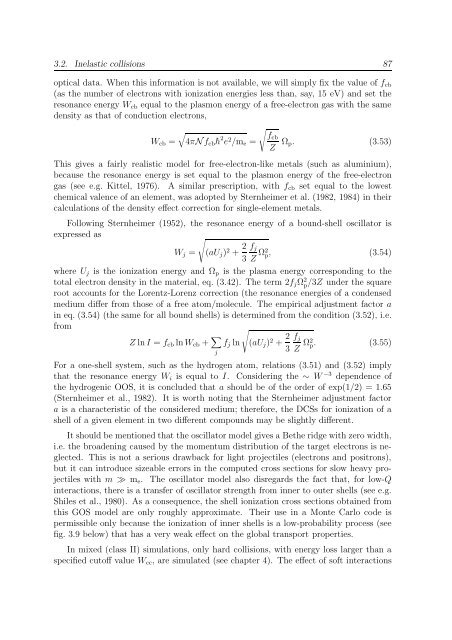PENELOPE 2003 - OECD Nuclear Energy Agency
PENELOPE 2003 - OECD Nuclear Energy Agency
PENELOPE 2003 - OECD Nuclear Energy Agency
Create successful ePaper yourself
Turn your PDF publications into a flip-book with our unique Google optimized e-Paper software.
3.2. Inelastic collisions 87<br />
optical data. When this information is not available, we will simply fix the value of f cb<br />
(as the number of electrons with ionization energies less than, say, 15 eV) and set the<br />
resonance energy W cb equal to the plasmon energy of a free-electron gas with the same<br />
density as that of conduction electrons,<br />
√<br />
√<br />
W cb = 4πN f cb¯h 2 fcb<br />
e 2 /m e =<br />
Z Ω p. (3.53)<br />
This gives a fairly realistic model for free-electron-like metals (such as aluminium),<br />
because the resonance energy is set equal to the plasmon energy of the free-electron<br />
gas (see e.g. Kittel, 1976). A similar prescription, with f cb set equal to the lowest<br />
chemical valence of an element, was adopted by Sternheimer et al. (1982, 1984) in their<br />
calculations of the density effect correction for single-element metals.<br />
Following Sternheimer (1952), the resonance energy of a bound-shell oscillator is<br />
expressed as<br />
√<br />
W j = (aU j ) 2 + 2 3 Z Ω2 p, (3.54)<br />
where U j is the ionization energy and Ω p is the plasma energy corresponding to the<br />
total electron density in the material, eq. (3.42). The term 2f j Ω 2 p /3Z under the square<br />
root accounts for the Lorentz-Lorenz correction (the resonance energies of a condensed<br />
medium differ from those of a free atom/molecule. The empirical adjustment factor a<br />
in eq. (3.54) (the same for all bound shells) is determined from the condition (3.52), i.e.<br />
from<br />
Z ln I = f cb ln W cb + ∑ √<br />
f j ln (aU j ) 2 + 2 f j<br />
j<br />
3 Z Ω2 p. (3.55)<br />
For a one-shell system, such as the hydrogen atom, relations (3.51) and (3.52) imply<br />
that the resonance energy W i is equal to I. Considering the ∼ W −3 dependence of<br />
the hydrogenic OOS, it is concluded that a should be of the order of exp(1/2) = 1.65<br />
(Sternheimer et al., 1982). It is worth noting that the Sternheimer adjustment factor<br />
a is a characteristic of the considered medium; therefore, the DCSs for ionization of a<br />
shell of a given element in two different compounds may be slightly different.<br />
It should be mentioned that the oscillator model gives a Bethe ridge with zero width,<br />
i.e. the broadening caused by the momentum distribution of the target electrons is neglected.<br />
This is not a serious drawback for light projectiles (electrons and positrons),<br />
but it can introduce sizeable errors in the computed cross sections for slow heavy projectiles<br />
with m ≫ m e . The oscillator model also disregards the fact that, for low-Q<br />
interactions, there is a transfer of oscillator strength from inner to outer shells (see e.g.<br />
Shiles et al., 1980). As a consequence, the shell ionization cross sections obtained from<br />
this GOS model are only roughly approximate. Their use in a Monte Carlo code is<br />
permissible only because the ionization of inner shells is a low-probability process (see<br />
fig. 3.9 below) that has a very weak effect on the global transport properties.<br />
In mixed (class II) simulations, only hard collisions, with energy loss larger than a<br />
specified cutoff value W cc , are simulated (see chapter 4). The effect of soft interactions<br />
f j
















